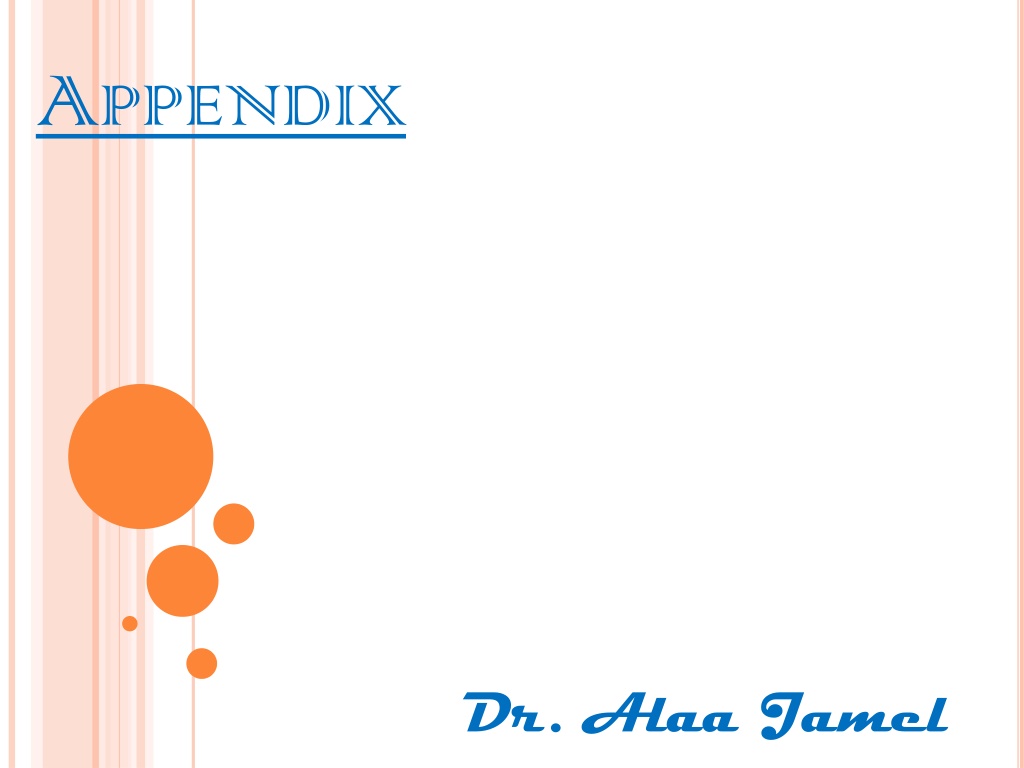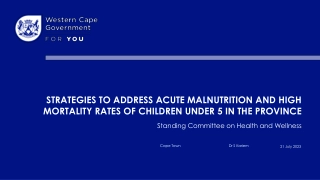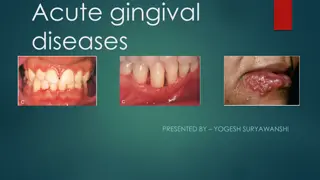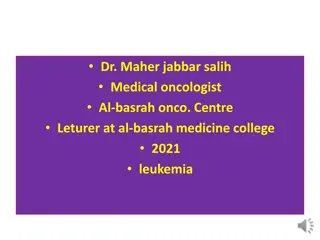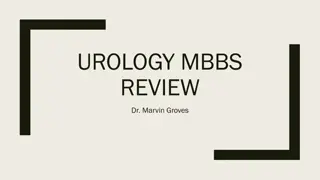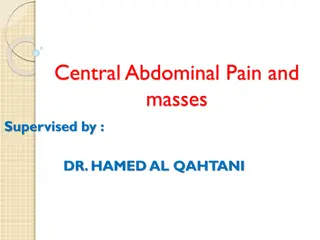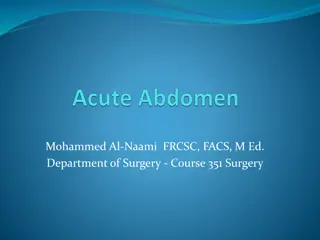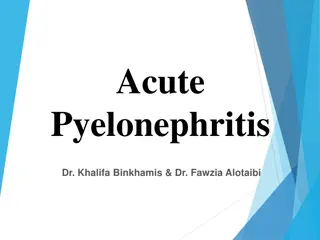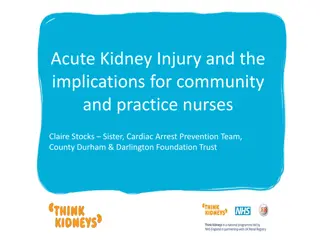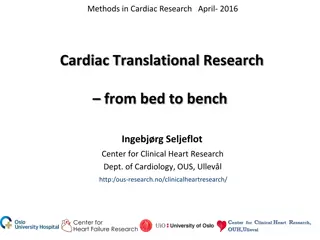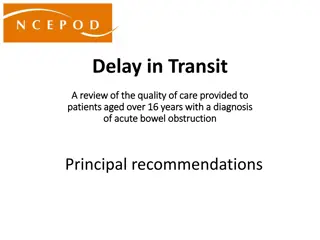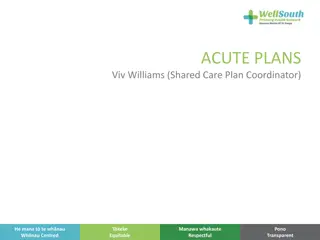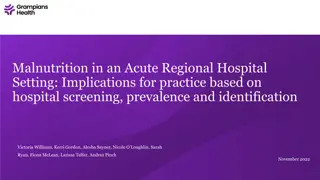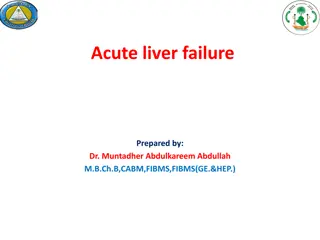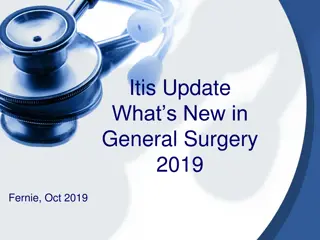Understanding Acute Appendicitis and its Clinical Implications
The appendix, a vermiform structure in humans, is prone to acute appendicitis, a common abdominal emergency. Knowledge of its anatomy, positions, and potential complications of obstruction is crucial for timely diagnosis and management. Learn about the vascular supply, perforation risks, and variable presentations of appendicitis across different age groups.
Download Presentation

Please find below an Image/Link to download the presentation.
The content on the website is provided AS IS for your information and personal use only. It may not be sold, licensed, or shared on other websites without obtaining consent from the author. Download presentation by click this link. If you encounter any issues during the download, it is possible that the publisher has removed the file from their server.
E N D
Presentation Transcript
APPENDIX Dr. Alaa Jamel
Vermiform appendix is present in human's musculans only; it s a blind muscular tube with mucosal and submucosal, muscular and serosal layers. Acute appendicitis is the commonest abdominal emergency in young adults
Anatomy : Various positions of the appendix a- retrocaecal 74% b- pelvic 21% c- paracaecal 2% d- sub cecal 1.5% e- preileal 1% f- post ileal 0.5%. The position of the base of appendix is constant, and found at the confluence of the three taenia coli of the caecum which fuse to form outer longitudinal muscle coat of the appendix. Mesoappendix arise from the lower surface of mesentery or the terminal ileum. The appendicular artery is a branch of the lower division of the iliocolic artery .appendicular artery is an end artery, so thrombosis of the artery cause necrosis of appendix
Acut appendicitis Acute appendicitis usually occurs when the appendix is obstructed by a- faecolith or b-foreign body in the lumen, by c- fibrous stricture in its wall from previous inflammation d- by enlargement of lymphoid follicles in its wall secondary to a catarrhal inflammation of its mucosa; rarely, e- it is associated with a carcinoid tumour near its base. Occasionally,f- acute appendicitis occurs proximal to an obstructing lesion (usually carcinoma) in the caecum or ascending colon. As the appendix of the infant is wide mouthed and well drained, and as the lumen of the appendix is almost obliterated in old age, appendicitis at the two extremes of life is relatively rare. However, when it does occur in these age groups it is poorly tolerated, and often diagnosed late.
The obstructed appendix acts as a closed loop; bacteria proliferate in the lumen and invade the appendix wall, which is damaged by pressure necrosis. The vascular supply to the appendix is made up of end-arteries, which are branches of the ileocolic artery. Once these thrombosed, gangrene is inevitable and is followed by perforation. There is no strict time relationship for this chain of events. An appendix may perforate in under 12 hours, but conversely it is not rare to see an acutely inflamed but not perforated appendix after 3 or 4 days.
The effects of appendicular obstruction depend on the content of the appendix lumen. If bacteria are present, acute inflammation occurs; if as sometimes happens, the appendix is empty, then a mucocele of the appendix results, due to continued secretion of mucus from the goblet cells in the mucosal wall. Appendicitis can occur in the non-obstructed appendix. Here, there may be a direct infection of the lymphoid follicles from the appendix lumen, or in some cases the infection may be haematogenous (e.g. the rare streptococcal appendicitis). The non-obstructed acutely inflamed appendix is more likely to resolve than the obstructed form.
Pathological Course The acutely inflamed appendix may resolve, but if so a further attack is likely. The inflamed appendix undergoes gangrene and perforates, either with general peritonitis or, more fortunately, with a localized appendix abscess
Clinical Features History The vast majority of patients with acute appendicitis present with marked localized pain and tenderness in the right iliac fossa. Pain typically, the pain commences as a central periumbilical colic, which shifts after approximately 6 hours to the RIF or, more accurately, to the site of the inflamed appendix as the adjacent peritoneum becomes inflamed. If the appendix is in the pelvic position, the pain may become suprapubic, with with urinary frequency as the bladder is irritated; if it is in the high retrocaecal position, the symptoms may become localized in the right loin with less tenderness on abdominal palpation
Rarely, the tip of the inflamed appendix extends inflamed appendix extends ix extends l palpation.s me suprapubic, with with urinary frequency as the bladder over to the left iliac fossa and pain may localize there. The colicky central abdominal pain is visceral in origin; the shift of pain is due to later involvement of the sensitive parietal peritoneum by the inflammatory process. Typically, the pain is aggravated by movement and the patient prefers to lie still with the hips and knees flexed. Nausea and vomiting usually occur following the onset of pain. Murphy described the diagnostic sequence as colicky central abdominal pain followed by vomiting, followed by movement of the pain to RIF. Anorexia is almost invariable. Constipation is usual, but diarrhoea may occur (particularly where the ileum is irritated by the inflamed appendix). is irritated ;
There may be a history of previous milder attacks of similar pain. With perforation of the appendix, there may be temporary remission or even cessation of pain as tension in the distended organ is relieved; this is followed by more sever and more generalized pain with profuse vomiting as general peritonitis develops.
Examination Pyrexia (around 37.5 C) and tachycardia are usual. - The patient id flushed, may appear toxic and is obviously in pain. - Movement exacerbates the pain. - The tongue is usually coated, and a fetor oris is present. - The abdomen shows localized tenderness in the region of the inflamed appendix. There is usually guarding of the abdominal muscles over this site with release tenderness. Coughing mimics the release test for rebound tenderness. - Rectal examination reveals tenderness when the appendix is in the pelvic position or when there is pus in the rectovesical or Douglas pouch. - In late cases with generalized peritonitis, the abdomen becomes diffusely tender and rigid, bowel sounds are absent and the patient is obviously very ill. Later still, the abdomen is distended and tympanitic, and the patient exhibits the Hippocratic facies of advanced peritonitis.
Symptoms in acute appendicitis Periumblincal colic Pain shift to rt iliac fossa Anorexia Nausea Clinical sign in appendicitis Pyrexia, localized tenderness in the right iliac fossa Muscle gardening, rebound tenderness
Sign to eleciate in appendicitis Pointing sign,, rovsing sign,,psoas,, psoas sign ,, obturator sign d.d; In children E.g. mesenteric lymph adenitis, meckels diverticulitis,, intussusception,, In adult; regional enteritis,, ureteric colic,, perforated peptic ulcer, torsion testis ,,pancreatitis,,, rectus sheat haematoma Adult females, pid, p.n, ectopic pregnancy, torsion or rapture ovarian cyst, endometritis. In elderly, diverticulitis, intestinal obstruction, colonic carcinoma, torsion appendix,, mesenteric infarction., , leaking aortic aneurysm
Investigation. The diagnosis of acute appendicitis is essentially clinical ,whoever descision to do operation based on clinical exam only can lead to remove normal appendix 15 30% of cases ,alvardo score system is widly used in diagnosis of acute appendicitis.
Symptoms score Migratory rif pain 1 Anorexia 1 Nausea and vomiting 1 Signs Tenderness 2 Rebound tenderness 1 Elevated temp. 1 Laboratory Leuckocytosis Sheft to the lf 1 Total A score of 7 or more is strongly predictive of acute appendicitis. Patient with 5-6 score, abdominal u/s or contrast c.t scan can use to reduce the rate of negative appedicictomy. 2 10
Treatment; Treatment; The treatment of acute appendicitis is appendicictomy ,in well diagnosed acute appendicitis urgent operation is essential to prevent the increase morbiditiy and mortility of peritonitis. . Immediate appendicectomy is not indicated in the following circumstance. is The patient is moribund with advanced peritonitis. Here the only hope - To improve the condition by intravenous drip and nasogastric aspiration, antibiotics and other resuscitative measures. The attack has already resolved; in such a case, appendectomy can be - Advised as an elective procedure, but there is no immediate emergency. An appendix mass has formed without evidence of general peritonitis. - Where circumstances make operation difficult or impossible, e.g. at sea.
Here reliance must be placed on a conservative regimen and the hope that resolution or local abscess will form, rather than on one's surgical skill with a razor blade and a bent spoon. Antibiotic prophylaxis is given preoperatively. When at operation peritonitis is discovered antibiotic therapy is continued; metronidazole and gentamicin, or a cephalosporin, are effective for both the anaerobic and aerobic bowel organisms, but this regimen may need to be supplemented or changed when the bacteriological sensitivities of the cultured pus become available after 24-48 hours. After appendectomy, a drain is inserted when; 1-there is sever inflammation of the appendix bed 2- a local abscess is present. 3- where closure of the appendix stump not perfectly done 4-Very occasionally, the inflamed and adherent appendix cannot be safely removed, and in such circumstances the area of the appendix requires adequate drainage and subsequent interval appendicectomy in about 3 months.
Problems encountered during appendicictomy; Normal appendix; is essential to search for other possible diagnosis as examin terminal ileum ,meckels,ovaries, Appendix cannot be found; examin the caecum curfully befor diagnose absent appendix 1%. appendicular tumour; if small tumor less than 2 cm can be removed by appendicictomy larger tumour should be removed by rt r Appendicular abscess and the appendix cannot be removed; this should be treated by local peritoneal toilet ,drainage of any abscess and intravenous antibiotic. Appendicular mass Not uncommonly, the patient will present with a history of 4 or 5 days of abdominal pain and with a localized mass in RIF. The rest of the abdomen is soft, bowel sounds are present and the patient obviously has no evidence of general peritonitis. In these circumstances, the inflamed appendix is walled off by adhesions to the omentum and adjacent viscera, with or without the presence of a local abscess. Immediate surgery in such circumstances is difficult.
Treatment Initial treatment is conservative (ochsner- shrren regimen) because surgery is difficult and may be dangerous because of inflammation and adhesion and may be difficult to find appendix and fecal fistula may occur. Preparation for operation should occur when clinical condition of patient deteriorate. The outlines of the mass are marked on the skin and regular examination of abdomin.oral fluid diet and a careful watch kept on the general condition, temperature ,pulse should recorded 4 hourly.fluid balance record , Metronidazole is commenced,pluse broad spectrum antibiotic but prolonged antibiotics are not given, as these may merely produce a chronic inflammatory mass filled with abscesses (the so-called antibioticoma). On this regimen, 80% of appendix masses resolve.
In the remaining cases, the abscess obviously enlarges over the next day or two and the temperature fails to subside in these conditions this type of regimen must discontinue., drainage of the abscess is instituted. In neglected cases, an appendix abscess may burst spontaneously through the abdominal wall, into the rectum, or into the general peritoneal cavity. If resolution occurs, appendicectomy is carried out after an interval of 3 months to allow the inflammatory condition to settle completely. Unless interval appendicectomy is performed, there is considerable risk of a further attack of acute appendicitis.
Appendicitis in pregnancy Appendicitis in pregnancy is no rarer or commoner than appendicitis in the general community, but it has a higher mortality and morbidity because it is confused with other complications of pregnancy. Differentiation must be made from pyelitis, vomiting of pregnancy, red degeneration of a fibroid or torsion of an ovarian cyst. Because the appendix is displaced by the enlarging uterus, pain and tenderness are higher and more lateral than in the usual circumstances. There is considerable danger of abortion, particularly in the first trimester.
A mass in the right iliac fossa The causes of a mass in the right iliac fossa are best thought of by considering the possible anatomical structures in this region. Appendix abscess or appendix mass. - Carcinoma of caecum (differentiated from the above by usually an older age - group, a longer history, often the presence of diarrhea, anaemia with positive occult blood and finally the barium enema examination). Crohn's disease (always to be thought of when there is a local mass in a - young patient with diarrhea). A distance gallbladder (which may quite often extend down as far as the - right iliac fossa).
- Pelvic kidney (or transplant). - Ovarian or tubal mass. - Aneurysm of the common or external iliac artery. - Retroperitoneal tumour arising in the soft tissue or lymph nodes of the posterior abdominal wall or from the pelvis. - Ileocaecal tuberculosis (rare in the UK, common in India). - Psoas abscess now rare. Post operative complications; Early * wound infection * intraabdominal abscess * paralytic ileus * respiratory complication *venous thrombosis and embolism *portal pyemia Fecal fistula. Late * adhesive intestinal obstraction * RT inguinal hernia
MUCOSELE OF APPENDIX; This condition occurs when the proximal end of the lumen is gradually occluded and obstruct usually by fibrous stricture and retaind secretion remain sterile. Neoplasm of appendix; Carcinoid tumour ;it arise from the argentaffin tissue (kulchitsky cell of the crepts of lieberkuhn),carcinoid tumour found as one in each 300 -400 appendices subjected to histological examination and 10 time more common than any other tumourr in the appendix. Carcinoid of appendix rarly metastasis .treatment When tumour size 2cm or more** when caecal wall envolve** when involvement of lymph node.
